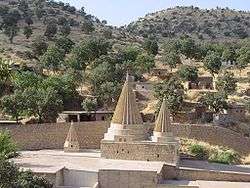Lalish
Lalish (Kurdish: لالش ,Laliş,[2][3] also known as Lalişa Nûranî) is a mountain valley[4] and temple[5] in Ninawa in Iraq. It is the holiest temple of the Yazidis. It is the location of the tomb of Sheikh Adi ibn Musafir, a central figure of the Yazidi faith.[6]
Lalish Laliş Lalişa Nûranî | |
|---|---|
Sacred place | |
 Conical roofs over the tomb of Şêx Adî in Lalish | |
 Lalish Location in Iraq | |
| Coordinates: 36°46′17.03″N 43°18′12.04″E | |
| Country | |
| Governorate | Ninawa |
| District | Shekhan District |
| De facto control | as part of Dohuk Governorate[1] |
| Founded | circa 2000 BCE |
The temple is above the town of Shekhan, which had the second largest population of Yazidi prior to the persecution of Yazidis by ISIL.[7] The temple is about sixty kilometers north of Mosul and 14 kilometers west from the village Ayn Sifna. The temple is built at about 1000 meters above sea level and situated between three mountains, Hizrat in the west, Misat in the south and Arafat in the north.[8]
At least once in their lifetime, Yazidis are expected to make a six-day pilgrimage to Lalish to visit the tomb of Şêx Adî and other sacred places.[6] These other sacred places are shrines dedicated to other holy beings. There are two sacred springs called Zamzam and the Kāniyā spring (White Spring).[9] Below Sheikh Adi's sanctuary, which also includes the tomb of Sheikh Hesen is situated a cave.[9]
Lalish is also the location of pirrā selāt (Ṣerāṭ Bridge) and a mountain called Mt. ʿErefāt which has sites significant in other faiths.[8] Yazidis living in the region are also expected to make a yearly pilgrimage to attend the autumn seven-day Feast of the Assembly,[10] which is celebrated from 23 Aylūl to 1 Tašrīn I.
It is located in the Shekhan District[11] since 1991.[12]
History
Lalish Temple dates back about 4000 years.[13]
In the early 12th century, Adi ibn Mosāfer moved to Lalish. Adi died in 1162 and was buried. During a major battle against the Yazidi in 1414, the tomb of Adi was razed.[10]
Beginning on 3 August 2014, Yazidi refugees fled from Sinjar and took shelter in the temple after the Islamic State of Iraq and the Levant placed Sinjar and its environs under siege.[6][13] When some 50,000 Yezidis trapped on Sinjar Mountain were freed by way of a land corridor opened by the Peoples's Protection Units (YPG) and Kurdistan Workers' Party (PKK),[14] the majority fled through Syria and circled around the north of the Sinjar mountain range to reach Lalish and Shekhan in Kurdistan Region.[7]
References
- "The map of Districts of Kurdistan Region". Kurdistan Region Statistics Office, Kurdistan Regional Government.
- "دوو پڕۆژە بۆ پەرستگەی لالش جێبەجێدەكرێن". Rûdaw (in Kurdish). 27 June 2019. Retrieved 19 December 2019.
- "Perestgeha Laliş tê nûjenkirin". Rûdaw. 27 July 2018. Retrieved 19 December 2019.
- C. J. Edmonds (2002). A Pilgrimage to Lalish. p. 10. Retrieved 13 August 2019.
- Luongo, Michael (21 August 2014). Fighting Back With Faith: Inside The Yezidis Iraqi Temple (PDF). kdp.se. The Daily Beast. p. 1. Retrieved 13 August 2019.
- Soguel, Dominique (August 12, 2014). "World Middle East A sanctuary for Iraqi Yazidis – and a plea for Obama's intervention". The Christian Science Monitor. Retrieved August 13, 2014.
- "Iraq crisis: the last stand of the Yazidis against Islamic State". The Telegraph. August 12, 2014. Retrieved August 14, 2014.
- Harrassowitz, O. (2009). From Daena to Din. Religion, Kultur und Sprache in der iranischen Welt: Festschrift für Philip Kreyenbroek zum 60. Geburtstag. p. 357. ISBN 978-3447059176.
- Kreyenbroek, Philip G.; Jindy Rashow, Khalil (2005). God and Sheikh Adi are Perfect. Wiesbaden: Harassovitz Verlag. pp. 37–38. ISBN 3447053003.
- Allison, Christine (July 20, 2004). "YAZIDIS i. GENERAL". Encyclopædia Iranica (online ed.). New York. Retrieved August 13, 2014.
- "Volunteers help restore holy Yezidi temple of Lalish". Rûdaw. 6 June 2019. Retrieved 13 August 2019.
- Minority Rights in the Middle East. OUP Oxford. 2013. p. 204. ISBN 9780191668883.
- Spencer, Richard (August 13, 2014). "Iraq dispatch: terrified Yazidi people seek refuge inside holy temple". The Telegraph. Telegraph Media Group Limited. Retrieved August 13, 2014.
- Tharoor, Ishaan (11 August 2014). "A U.S.-designated terrorist group is saving Yazidis and battling the Islamic State". Washington Post. Retrieved 15 December 2018.
| Wikimedia Commons has media related to Lalish. |